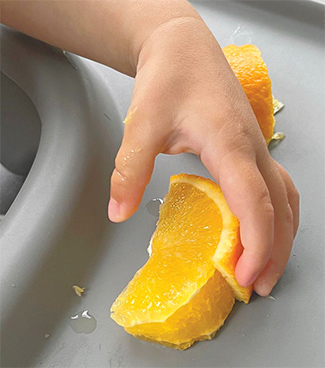Baby-led weaning (BLW)
Some parents choose to introduce solids by letting their baby eat pieces of food on their own. This practice is called baby-led weaning, or BLW, and it can work for most babies. However, certain criteria must be met before you start. Your baby must be
- At least 6 months old (for premature babies, use the corrected age)
- Healthy and developing normally for her age
- Able to sit in a high chair without support for the duration of a meal (about 15 to 20 minutes)
- Able to pick up an object, bring it to her mouth, and let go of it
Not sure if your child is ready? Don’t hesitate to talk to your baby’s healthcare professional.
Which foods to offer?
![]() The key is to start with iron-rich foods and then continue with nutritious and varied foods.
The key is to start with iron-rich foods and then continue with nutritious and varied foods.
The order for introducing solids is the same for all babies, regardless of how you choose to do it. Start with iron-rich foods and move on to a variety of other nutritious foods (see 6 to 12 months—Your baby’s first foods).
Families who practise BLW usually find it easier to feed their baby the same foods as the rest of the family. But your baby’s portion should be made without salt or sugar.
Good to know...
When your baby eats food cut into pieces, his mouth and tongue movements are not the same as when he eats pureed food. For this reason, it’s best not to offer both textures at the same meal.
How to prepare food for BLW

For your baby’s safety, avoid foods that are a choking hazard. Foods that are hard, small and round, smooth and sticky present the greatest risk. See Choking risk: Be extra careful until age 4
Texture
The food you offer your baby must be soft in texture. She must be able to mash food against her palate with her tongue.
Some foods that are naturally soft (e.g., ripe bananas, pears, and peaches) can be served raw. Be sure to wash raw food thoroughly before offering it to your child.
Other foods, such as meats, fish, and certain fruits and vegetables, must be cooked first. Grains and legumes can be used in recipes (e.g., muffins, pancakes) or served as spreads.
Size and shape
Offer pieces large enough for your baby to hold in one hand and bring to her mouth. The pieces must be long enough to extend past her closed fist (e.g., large strips of chicken or sticks of tofu). Over time, your baby will become more skilled and able to handle shorter pieces or other shapes.
Babies who feed themselves are no more at risk of choking than babies fed on purées. However, they may gag more often (see Gagging).
How much does my baby eat?
Some parents worry about the amount of food their baby eats once she starts feeding herself.
Rest assured, your baby knows her appetite better than anyone. To learn how to recognize her signals, see Appetite. Keep in mind that milk will still be her main source of nutrition until she is about 1 year old.
At your childcare centre
![]() Babies who feed themselves can take a long time to finish a meal. That’s normal; they’re learning to become independent. If you’re short on time at one of your baby’s meals, you can spoonfeed her for that meal and continue with BLW next time.
Babies who feed themselves can take a long time to finish a meal. That’s normal; they’re learning to become independent. If you’re short on time at one of your baby’s meals, you can spoonfeed her for that meal and continue with BLW next time.
Some childcare centres are receptive to BLW, but that’s not always the case. Ask the people in charge at your centre what their practices are.
If you have questions about BLW, you can check with your CLSC about the resources available in your area.


